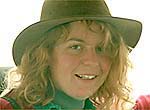
These are children from Kalahuta Island on our trip to Bolivia and the story that goes with them....
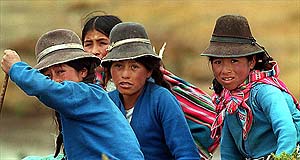 On
day 3 of our trip, we took an excursion to Kalahuta Island. It was almost
directly across the lake from us. Early a.m. we were loaded on a
large hydrofoil boat to cross the lake. We arrived offshore of a small
fishing village on an island that couldn't possibly have electricity and
sounded the horn. After what seemed like way too long for impatient
tourists, we saw a man on the shore get into a small boat and motor out
towards us. We were told that to get to the island we were to visit,
we had to go through a very long stretch of shallow channels in the vegetation,
so this man was here to shuttle us through to the island where the nice,
cozy hydrofoil we were on couldn't go. It pulled along side and we
boarded what had to be the poorest example of marine safety I have ever
seen.
On
day 3 of our trip, we took an excursion to Kalahuta Island. It was almost
directly across the lake from us. Early a.m. we were loaded on a
large hydrofoil boat to cross the lake. We arrived offshore of a small
fishing village on an island that couldn't possibly have electricity and
sounded the horn. After what seemed like way too long for impatient
tourists, we saw a man on the shore get into a small boat and motor out
towards us. We were told that to get to the island we were to visit,
we had to go through a very long stretch of shallow channels in the vegetation,
so this man was here to shuttle us through to the island where the nice,
cozy hydrofoil we were on couldn't go. It pulled along side and we
boarded what had to be the poorest example of marine safety I have ever
seen.
It did have a fresh coat of paint on the outside, and I think it was holding the boat together.
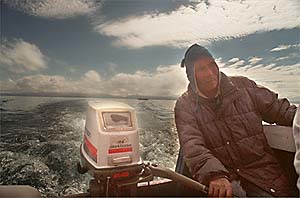 We all lined carefully up along either side of the small boat as the one
we called "Evenrude man" negotiated what seemed like miles of narrow, shallow
weed-ridden swamp channels in the tall blonde grass. He didn't speak,
nor did his expression change at all. His skin was dark and very
leathery. His toes poked out of worn, rubber looking sandals and
looked more like hooves than feet. With aged, sunken eyes and dried, shrunken
skin, his appearance was likened to that of the iceman recently found in
the Himalayas. Eventually, as we were estimating the waters' depth
to be around 3 to 4 feet, we noticed we were about to "dock". This
dock was a collection of several medium sized sticks above the water with
boards nailed and balanced above them.
We all lined carefully up along either side of the small boat as the one
we called "Evenrude man" negotiated what seemed like miles of narrow, shallow
weed-ridden swamp channels in the tall blonde grass. He didn't speak,
nor did his expression change at all. His skin was dark and very
leathery. His toes poked out of worn, rubber looking sandals and
looked more like hooves than feet. With aged, sunken eyes and dried, shrunken
skin, his appearance was likened to that of the iceman recently found in
the Himalayas. Eventually, as we were estimating the waters' depth
to be around 3 to 4 feet, we noticed we were about to "dock". This
dock was a collection of several medium sized sticks above the water with
boards nailed and balanced above them.
Evenrude man turned off the engine and lifted the weed entangled propeller out of the water and we CAREFULLY stepped up to the peer. Our guide, Ivan talked briefly about the unsafe, parasitic conditions of the water, but nobody listened, too busy taking in the view above. He told us that we were on the West side of the island and that the Aymara Indians believed that since the west was where the sun went down, that the west side of the island was where you went to die. "No one lives on this side of the island, except one man. He lives in the little hut you see here. He is a little mad, too." We saw a silhouette above us on the hillside, but none of us could discern if this was him. We began to climb the terraced hillside and began to notice several native children - or rather they noticed us. Ivan told us that the Andes were originally under the ocean floor and were pushed up, bringing several fossils and sea shells. As we walked, soon we were all holding handfuls and pockets of
inch-long white snail shells.
The boys noticed that we were digging in the dirt for interesting rocks and began to offer us stones. I asked one what kind it was and he replied, in Spanish, "It's a rock". I thanked him and took it. Several nice rocks and shells later, we had decided to give them some Bolivianos. A Boliviano was at the time worth about 20 cents. Vic offered a coin to each, only to hear them squabble over who got which coin. Seems that one of the coins was a 2 Boliviano and somebody felt he had been cheated. Before long, we were faced with each boy with his hand out, quietly asking for more. Then, assuming we would rather buy something, we were then presented with several new rocks and plants. I asked what type they were and he only rubbed the plant between his fingers and smelled it.
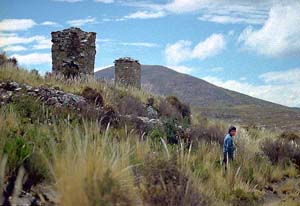
I smelled the plant and it was pretty sour smelling... perhaps a spice. I thanked him and shook my head, no. The group was now ahead of us and Ivan was beginning to explain the stone towers we saw. He showed us that the openings on them were on the west. This meant that they were burial towers, and that the exit was for the spirit to leave. There were several other buildings in ruin. They were for more prominent families. We were told that these buildings and the terraces cut into every hill in sight were all built before the Incas came to the Andes. It was also believed by the Aymara that people had two parts to their soul, the physical body and the spirit. On this side of the island, lived the spirits of those who had gone before.
If you stayed the night on the west of the island, your spirit may stay with the others and you'd either die or become mad. So, every night at the end of the work-day as the sun goes down, all the farmers and workers scurry up the hillside to return safely home.
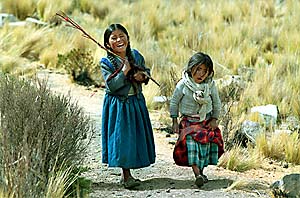 We turned and continued up in the eastern direction, passing two little
girls shooing pigs along the path with a large stick. We were told
we would climb to the 'saddle' at the crest of the hill, between the two
higher points on the island. This was when the altitude became a
noticeable burden. The boys had discovered that we were out of Bolivianos
and returned to whatever they did before we arrived. The group was
now strung out in a large string up the hillside. Some people noticed
and picked up rocks as you could hear the negotiations of trade with pretty
rocks over shells.
We turned and continued up in the eastern direction, passing two little
girls shooing pigs along the path with a large stick. We were told
we would climb to the 'saddle' at the crest of the hill, between the two
higher points on the island. This was when the altitude became a
noticeable burden. The boys had discovered that we were out of Bolivianos
and returned to whatever they did before we arrived. The group was
now strung out in a large string up the hillside. Some people noticed
and picked up rocks as you could hear the negotiations of trade with pretty
rocks over shells.
Then, I spotted a strange, curved claw-looking piece. I picked it up and instantly, a small boy was beside me with it in his hand. He held it up to his head where a horn would be, and pointed out to the sheep in the field. Vic had taken out ahead of everyone at a very fast pace up the hill, and was now slowing down. I had decided that breathing was much easier if your steps were in rhythm with your breathing; two steps to one breath. This not only kept me in breath, but paced my climb (or so I thought.) The Mutton's oldest boy, Edwin quickly came sprinting up past me. I showed him the horn and tapped it on a stone. "Look, it's a raptor claw!" He smiled and told me the book was better than the movie. He was reading "Into thin air" for his trip here and was excited about climbing in the altitude.
Before long, most of us were at the crest, looking for places to sit and catch our breath. After watching all the others shoot pictures of the landscape knowing full well their attempts couldn't ever do justice to the panorama, I decided to try a technique I once saw. I shot stood still and turning 360 degrees around, shot 7 shots in a row to encompass the entire view. Our guide pointed out the tilted exposed rock layers and said that this was a good place to find fossils. Soon, you could see grown, intelligent men all over the hillside holding rocks over their heads, banging them against each other. Now, the trade negotiations changed from rocks and shells to fossilized clam shells and a strange wiry plant that left impressions in the sandstone. Scott stood, beaming, holding a small stone to his chest, and with a little coaxing, showed us his picture perfect plant fossil embedded beautifully in a 4 inch square layer.
Edwin Mutton, after having announced his intentions of climbing the nearer of the two peaks had disappeared to do so. Before anyone noticed him gone, he began to RUN up the hill. "STOP RUNNING" we all shouted. But he wasn't listening. One member commented about his mother allowing him to do this. Another member commented that the first couldn't be a parent if he didn't recognize that she could do nothing about the teen. By this time, the altitude had settled it's score with Edwin and we could all see him sitting on a rock, heaving for air about halfway up the slope. More rock-beating transpired until we witnessed Edwin's summit attempt. It was here that I saw the first insects of the trip. There were very large ants (very angry about having their rocks beaten open) all over. I had read that a variety such as this delivered a nasty, venomous bite, so we figured caution would be in order.
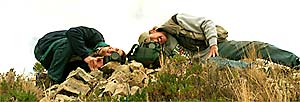
Since nobody remembered to lug a bulky, awkward tripod up with us, we were forced to place the cameras on a pile of rocks on the hill for our group shot here. Fortunately, nobody broke anything scurrying down to get into the picture while the timer was running. Ivan told us we should hurry, since there was a picnic prepared and waiting for us at the bottom of the hill; so we moved along. Members, again began to string back out across the hill as we moved down through the fields again. Now, the children were out in force. They weren't shy about holding out the hand, or finding new, ingenious ways to attract attention.
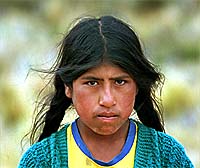 Vic and I were surprised by one young girl, though. Since the people
before us had passed so far ahead, we didn't see which path they took and
when I started off in one direction, this young girl who was just standing
alone in her field nearby pointed another direction and said something
that must have meant to go this direction.
Vic and I were surprised by one young girl, though. Since the people
before us had passed so far ahead, we didn't see which path they took and
when I started off in one direction, this young girl who was just standing
alone in her field nearby pointed another direction and said something
that must have meant to go this direction.
She didn't ask for any money or come running up, begging. She seemed more upset that we were tracking across the field she was working in. But we hurried along. 25 children and a half dozen rocks too good to pass up later, we arrived at the site of the Atapi picnic.
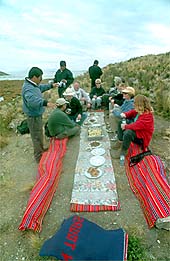 3 long blankets spread out in a line with logs and large rocks beside to
sit on. The bright blankets were also spread over the rock seats
and trays of very interesting food were spread across the ground.
Not all of the group had returned, but we sat anyway and were offered more
bottled water and Ivan began to explain the Atapi. This is how the
traditional lunch was done when the Aymara were out working in the fields.
3 long blankets spread out in a line with logs and large rocks beside to
sit on. The bright blankets were also spread over the rock seats
and trays of very interesting food were spread across the ground.
Not all of the group had returned, but we sat anyway and were offered more
bottled water and Ivan began to explain the Atapi. This is how the
traditional lunch was done when the Aymara were out working in the fields.
Each person would bring food that everyone would then share. By now, the rest of the group was coming around the hillside. Our close friend, Bob Shambura, the stockbroker from Chicago was being followed by a group of 20 or so small children.
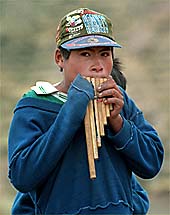 When he saw them, Ivan hurried up to tell them they couldn't stay during
the meal. Bob interjected that he'd contracted one to perform 3 songs
for us while we ate. Ivan reluctantly agreed and spoke very sternly
to the children about where they were allowed to sit and that they were
not to interfere with us. Bob nodded at the boy and repeated in horribly
americanized Spanish, "three songs for 10 Bolivianos" We were served
some more normal foods like chicken and boiled eggs (that were not exactly
like ours- the yolks were bright orange and very large).
When he saw them, Ivan hurried up to tell them they couldn't stay during
the meal. Bob interjected that he'd contracted one to perform 3 songs
for us while we ate. Ivan reluctantly agreed and spoke very sternly
to the children about where they were allowed to sit and that they were
not to interfere with us. Bob nodded at the boy and repeated in horribly
americanized Spanish, "three songs for 10 Bolivianos" We were served
some more normal foods like chicken and boiled eggs (that were not exactly
like ours- the yolks were bright orange and very large).
In addition, they had included a great many local treasures. Since there have been discovered over 300 naturally occurring varieties of potatoes, there were several samples for us. One was the closest relative, the Yucca, and one was a freeze dried type that had turned blackish purple. It was boiled also, and tasted nothing like a potato - more like an olive. By now, the young boy had begun playing some traditional melodies on his zampon~a - the simple pan flute used in all music of the area. Also on the menu were these interesting little fishes. Interesting because they were tiny little minnows that had been freeze-dried in someone's front yard and then batter-dipped in some sort of spices. On a plate, they didn't seem too appetizing to me, what with the eyes and fins and all, but Vic claims they were delicious and Bob agreed.
Other treats were the local ava beans (an oversized lima bean) a strong, salty, goat cheese, and local corn on the cob. I don't know if it's a result of the altitude or the soil, but the corn was very strange. It's kernels were 3 times the size of our corn, had a tough, chewy skin and very little flavor. It was clear that the most common method of food preparation or preservation was to freeze dry food. Since the altitude removed so much of the moisture from the air, and the cold, winter nights (it was winter down there) dropped well below freezing, it was common to see blankets in the yards that just had potatoes or fish, or unknown foods spread out for the night. Bob reminded the young boy that he had a contract for 3 songs, not just 2, so after a little more thought and preparation, the music continued, pleasantly echoing off the hills nearby. Our dessert was brought in the form of tangerines and kiwi brought from the lower, jungle area of Bolivia.
We all stared with stars in our eyes at the kiwi that was so large. It actually didn't resemble our kiwi much, since the fruit was literally two regular kiwi's connected together like Siamese twins - and grown a little bigger. We had a few laughs over the usefulness of the leatherman tools both Bob and I had thought to bring with us, then helped pack up the remaining food and blankets for our return. The helpers argued that they wanted no assistance, but since they were so greatly outnumbered by our group, we soon were all helping to carry blankets, or whatever we could get our hands on down the hill toward our waiting boat.
 Again, we passed the tiny, stone hut of the old man; but this time, I looked
down and noticed something. There, on the side wall just below the
roof, I spotted a line of perhaps 15 human teeth! Roots and all!
So, like the tourist that I was, I took a picture of them and announced
the discovery to all the others.
Again, we passed the tiny, stone hut of the old man; but this time, I looked
down and noticed something. There, on the side wall just below the
roof, I spotted a line of perhaps 15 human teeth! Roots and all!
So, like the tourist that I was, I took a picture of them and announced
the discovery to all the others.
- Perhaps, not the smartest thing, since this meant that all the others in line behind me were now obligated to stop and ponder their placement there. We jointly concluded that the old man, not wanting to misplace them after they had each been lost, laid them there for posterity. Again, we looked up and found Bob surrounded by a swarm of small children. Half had stayed behind to receive the empty water bottles that the hotel staff would leave for them, but it seemed that now the remaining population of the island's children was now pulling on Bob's arm for money. We saw Bob hold something (presumably money or candy) in the air and the crowd- excuse me, mob went mad, there was a scramble and Bob was free. I'm not sure if the trade was intended to be for pictures, but there was no chance for any photos to be taken. Bob and his wife Wendy were then, down the hill and tiptoeing over the mislaid boards of the 'dock'.
Here, however, we did notice that the girls all had outfits exactly matching each other. The same fabric was used to sew perhaps 8 outfits they were wearing, and both the boys and girls were all wearing identical blue sweaters. Evenrude man started the engine and we were on our way. The children all happily chattering at us as we left, waving and shouting; that is until someone raised a camera. As soon as they thought we were taking a picture, all simultaneously ducked and hid. Puzzled, we were told that since we could no longer pay them to take the pictures, they did not want to have any taken for free. Nobody moved the entire 20 minute ride back to the hydrofoil. Perhaps it was fatigue from climbing the hill at altitude, but most likely, it was fear of capsizing the tiny, dilapidated boat. We were, however, able to spot a unique underwater plant that glowed a fluorescent blue-green.
Once, safely, warmly back on our modern hydrofoil home, the stories began to fly and Scott announced that he felt justlike a little kid clutching his prized fossil. I asked if I could see it again, to which he replied, "No way, you're a girl".
Jennifer Dudley - Bolivia/June 1998.
Return to the SSSP98 Home Page